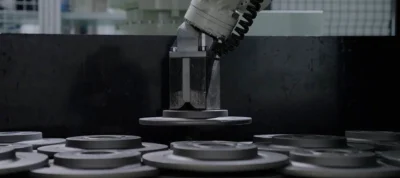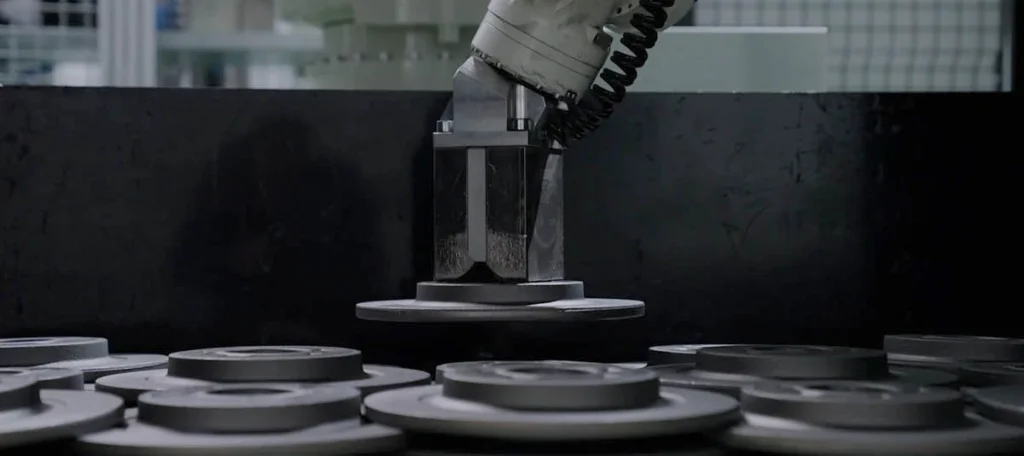
Photoneo 3D Vision Powers High-Speed Bin Picking of Heavy Brake Discs for Leading Italian Foundry
Modern industrial automation works best when smart vision systems and robots team up. A great example of this is a project by Tiesse Robot for Fonderia di Torbole, a well-known Italian foundry that specializes in parts for the automotive industry.
The aim was to fully automate the handling of brake discs, starting with picking the raw parts and ending with getting them ready for painting.
The system includes three connected robotic stations that work together, relying on Photoneo’s 3D vision to guide the robots with accuracy and reliability – even in messy, unpredictable environments.
Project overview:
- End Customer: Fonderia di Torbole
- Integrator: Tiesse Robot
- Application: Robotic Bin Picking of Raw Brake Discs (Brake Discs Picking)
- Photoneo Products: PhoXi 3D Scanner XL, Bin Picking Studio
- Distributor: The whole project was made possible thanks to a strong collaboration with our local distributor, Basler Italy.
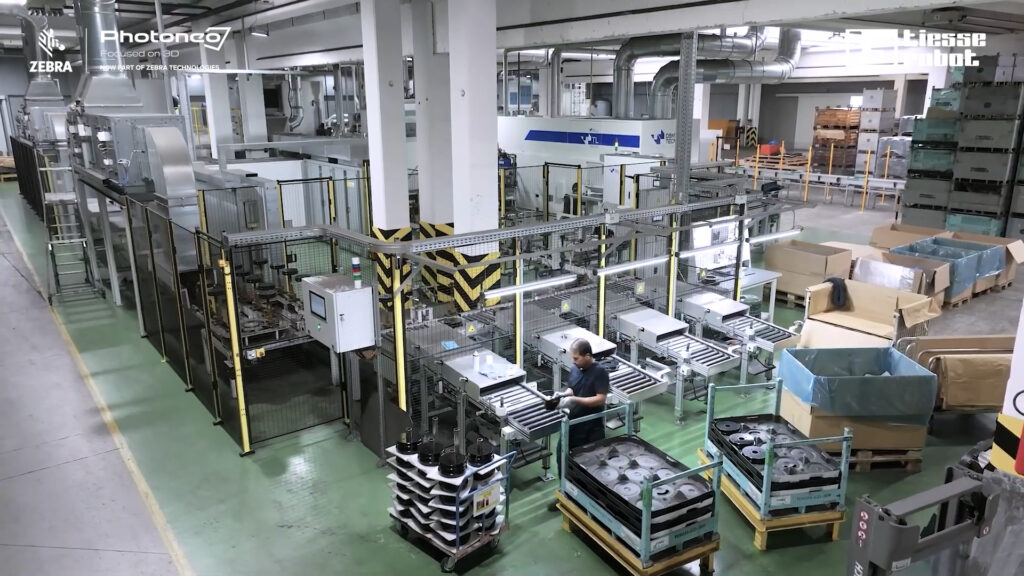
The Challenge: Automating the Unpredictable
The goal was to fully automate the handling of heavy brake discs, from a semi-structured bin to the final preparation for painting. The initial stage, bin picking, presented a significant hurdle. The raw parts – cast iron and steel brake discs weighing up to 15 kg each – are piled in large bins.
A successful automation solution needed to:
- Reliably identify and locate discs in any orientation within a large bin.
- Handle heavy, metallic parts with potentially reflective or dark surfaces.
- Provide precise 3D coordinates to a robot for a secure grip.
- Calculate collision-free paths for the robot arm and gripper to prevent damage to the parts, the bin, or the robot itself.
- Achieve a fast cycle time (under 45 seconds) to feed the rest of the production line without interruption.
The Solution: Intelligent 3D Vision by Photoneo
Tiesse Robot built the first of three robotic islands around a Kawasaki RS080N robot guided by Photoneo’s cutting-edge bin picking solution. This combination transformed the challenging task into a reliable and efficient automated process.
The system leverages two core Photoneo technologies:
The Role of PhoXi 3D Scanner XL
Chosen for its large scanning volume and high-resolution output, the PhoXi 3D Scanner is perfectly suited for large industrial bins. Using advanced structured light technology, it captures a detailed and accurate 3D point cloud of the entire bin in a single scan, effectively mapping the position and orientation of every visible brake disc, regardless of their chaotic arrangement. Its robust build ensures flawless performance in the demanding foundry environment.
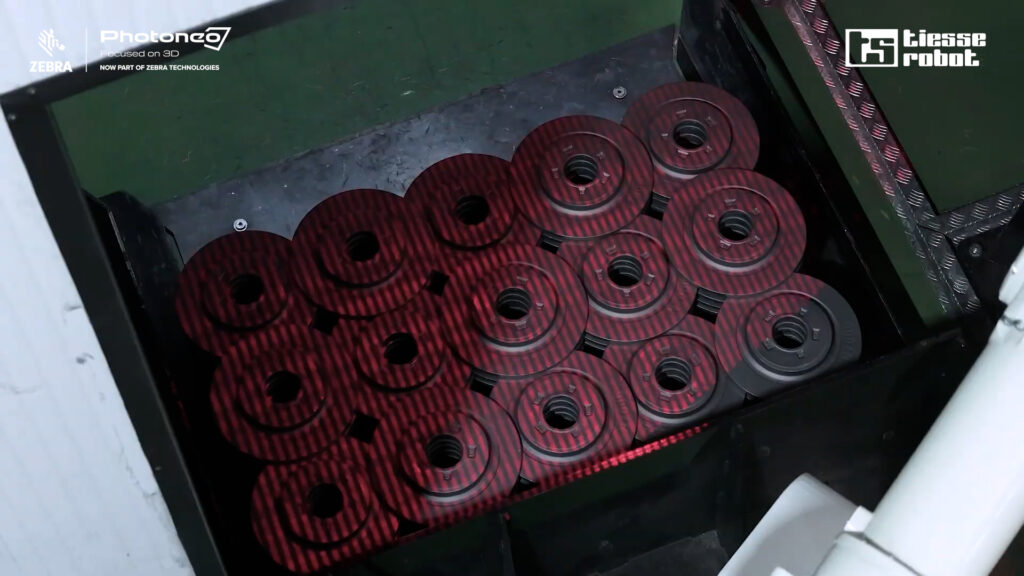
The Role of Bin Picking Studio
This powerful vision intelligence software serves as the brain of the operation. After the PhoXi 3D Scanner XL captures the scene, Bin Picking Studio instantly processes the point cloud.
- Localization & Part Recognition: The software identifies every pickable brake disc, determining its precise 3D position and orientation.
- Path Planning & Collision Avoidance: Crucially, it calculates the optimal, collision-free trajectory for the Kawasaki robot to approach, grip, and extract the selected disc from the cluttered bin.
- Robot Communication: It seamlessly communicates the picking coordinates and path to the robot controller, enabling autonomous operation.
A Seamless, Vision-Guided Workflow
In the first robotic island, the automated sequence relies on 3D vision for maximum efficiency:
- The PhoXi 3D Scanner XL performs a scan of the bulk bin containing the raw brake discs.
- Bin Picking Studio analyzes the 3D data, identifies the best candidate for picking, and calculates a safe extraction path.
- The software provides the orientation data to the Kawasaki robot, which uses a magnetic gripper to securely pick the disc.
- If Bin Picking Studio indicates a disc is upside down, the robot automatically performs a flipping maneuver before placing the part correctly onto a powered roller conveyor, ensuring it is perfectly prepared for the next stage of turning.
This flawlessly executed first step guarantees a continuous and synchronized flow of material to the subsequent islands, which handle post-turning operations, inspection, and final outfeed.
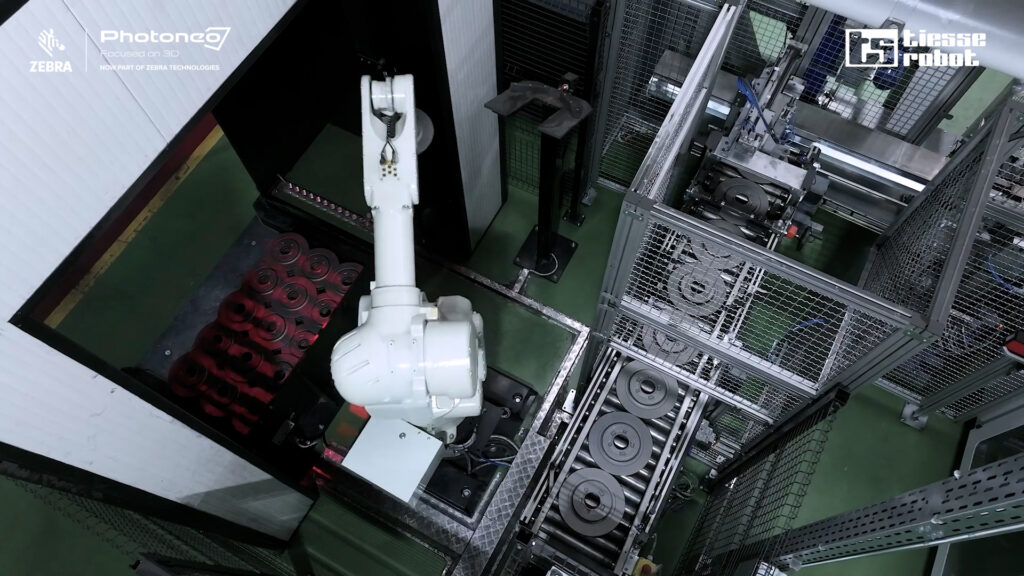
How It Works: A Three-Stage Automated Process
The entire solution is orchestrated across three interconnected robotic islands, each handling a specific phase of the production cycle to ensure a continuous and synchronized workflow from raw part to finished product.
Stage 1: Vision-Guided Brake Discs Picking
The process begins at the first island, where a Kawasaki Robotics RS080N robot is tasked with retrieving raw brake discs from bulk bins.
Guided by a Photoneo PhoXi 3D Scanner, the robot identifies the precise orientation of each disc. Using a magnetic gripper, it securely picks a correctly positioned part – or flips an upside-down one – before placing it onto a powered roller conveyor that feeds the turning line.
Stage 2: Post-Turning Operations
After turning, the discs arrive at the second island for intermediate machining. Here, a high-payload Kawasaki Robotics ZX165U robot, equipped with a dual pneumatic three-jaw gripper, takes over. It first uses a 2D vision system (TS-Vision) to determine the correct rotational position (phasing) of the disc.
The robot then manages the loading and unloading of two drilling units and a subsequent balancing station. Based on the results, compliant discs are sent to a washing machine, while any rejects are automatically diverted to a separate conveyor.
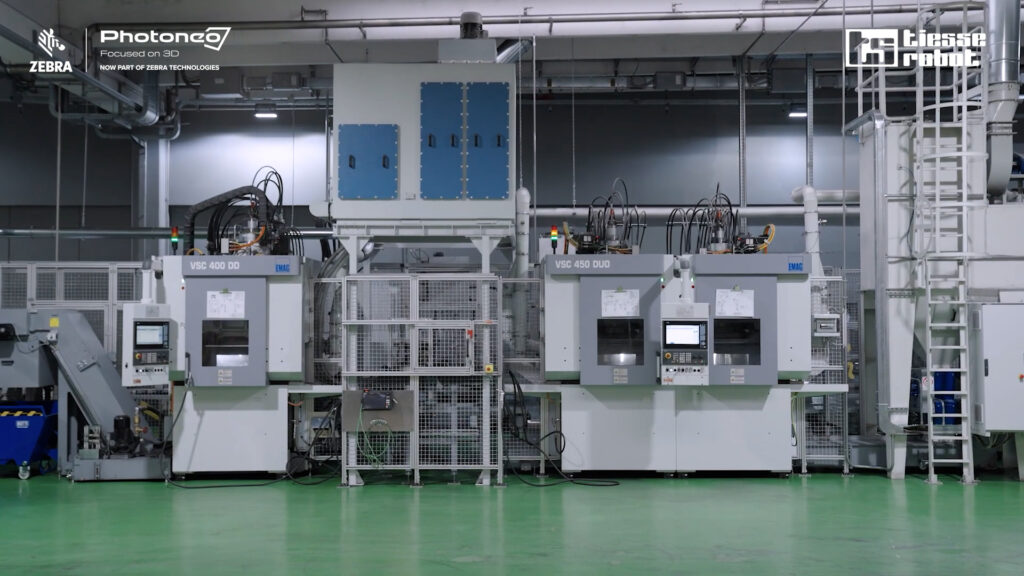
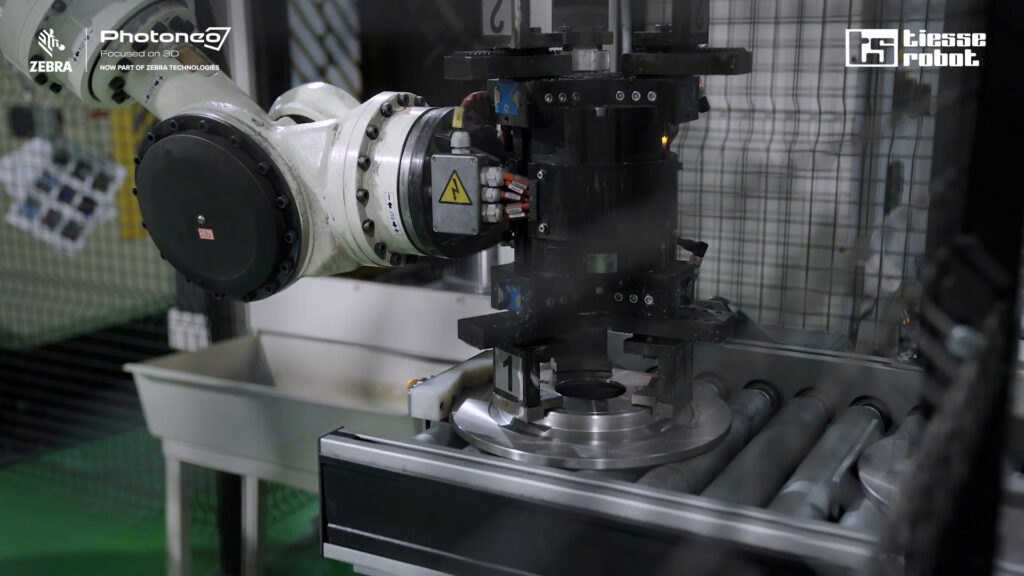
Stage 3: Final Inspection and Outfeed
In the final stage, the washed discs undergo inspection and marking. Another Kawasaki Robotics ZX165U robot handles the parts, moving them between several units. The disc first undergoes a dimensional inspection, followed by unique identification marking with a laser for full traceability.
Finally, the robot places the finished disc either onto the customer’s outfeed roller conveyor or onto a transfer belt leading to the painting system, completing the automated cycle.

Results: The Foundation for Flawless Brake Discs Picking
By integrating Photoneo’s 3D vision, Tiesse Robot provided the foundry with a solution that unlocked complete automation for the brake disc line. The Photoneo-powered bin picking cell delivered:
- Unmatched Reliability: Consistent and accurate picking of heavy, randomly oriented parts, eliminating manual labor for a strenuous and repetitive task.
- High Throughput: The system met the demanding cycle time of 45 seconds, ensuring the entire production line operates at peak efficiency.
- Intelligent Automation: The combination of 3D scanning and advanced path-planning software provides the intelligence needed for a smooth operation.
- Process Continuity: By solving the most complex part of the process first, Photoneo’s technology became the cornerstone of the entire automated system, enabling a seamless end-to-end workflow.
Curious how can PhoXi 3D Scanner solve your automation challenge? Take a look at the latest generation of our revolutionary 3D scanner for the most demanding industrial tasks.
